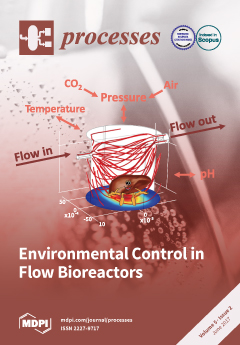A series of P
DLLA-PEG
1k-P
DLLA tri-block co-polymers with various compositions, i.e., containing 2–10 lactoyl units, were prepared via ring opening polymerisation of
d,
l-lactide in the presence of poly (ethylene glycol) (PEG) (
Mn =
[...] Read more.
A series of P
DLLA-PEG
1k-P
DLLA tri-block co-polymers with various compositions, i.e., containing 2–10 lactoyl units, were prepared via ring opening polymerisation of
d,
l-lactide in the presence of poly (ethylene glycol) (PEG) (
Mn = 1000 g·mol
−1) as the initiator and stannous 2-ethylhexanoate as the catalyst at different feed ratios. P
DLLA-PEG
1k-P
DLLA co-polymers were then functionalised with acrylate groups using acryloyl chloride under various reaction conditions. The diacrylated P
DLLA-PEG
1k-P
DLLA (diacryl-P
DLLA-PEG
1k-P
DLLA) were further polymerised to synthesize soluble hyperbranched polymers by either homo-polymerisation or co-polymerisation with poly(ethylene glycol) methyl ether methylacrylate (PEGMEMA) via free radical polymerisation. The polymer samples obtained were characterised by
1H NMR (proton Nuclear Magnetic Resonance), FTIR (Fourier Transform Infra-red spectroscopy), and GPC (Gel Permeation Chromatography). Moreover, the diacryl-P
DLLA-PEG
1k-P
DLLA macromers were used for the preparation of biodegradable crosslinked hydrogels through the Michael addition reaction and radical photo-polymerisation with or without poly(ethylene glycol) methyl ether methylacrylate (PEGMEMA,
Mn = 475 g·mol
−1) as the co-monomer. It was found that fine tuning of the diacryl-P
DLLA-PEG
1k-P
DLLA constituents and its combination with co-monomers resulted in hydrogels with tailored swelling properties. It is envisioned that soluble hyperbranched polymers and crosslinked hydrogels prepared from diacryl-P
DLLA-PEG
1k-P
DLLA macromers can have promising applications in the fields of nano-medicines and regenerative medicines.
Full article





